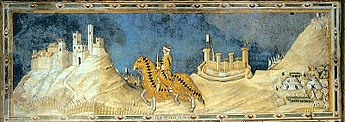Guidoriccio da Fogliano at the siege of Montemassi
Guidoriccio da Fogliano at the siege of Montemassi (Italian: Guidoriccio da Fogliano all'assedio di Monte Massi) is a fresco on the western wall of the Sala del Mappamondo in the Palazzo Pubblico in Siena. It shows Guidoriccio da Fogliano, the commander of the Sienese troops, on horseback against the background of a landscape in which the siege of Montemassi takes place..
For a long time it was assumed that the work was painted in 1330 by Simone Martini (1284-1344). This dating made it one of the first secular portraits and one of the first monumental landscape paintings. It is widely considered a masterpiece of European painting.
In 1977, a frequently acrimonious debate started among art historians about the question whether Martini was indeed the artist. On the same wall in the Sala del Mappamondo another fresco has been discovered that could support the theory that the Guidoriccio is not as old as originally thought, and not a work by Martini. However, this matter is still unresolved.
In the middle of the fresco Guidoriccio da Fogliano, a condottiero (mercenary officer) and commander of the Sienese troops, is depicted on horseback. He is shown in profile with a Field Marshal’s baton in his hand. On the left Montemassi can be seen surrounded by ramparts. To the right of the central figure of Guidoriccio there is a siege engine with the flag of the Sienese Republic in top. Further to the right there is a group of tents at the foot of a hill, with white and black flags and pennants flying. At the bottom of the fresco the year of the conquest of Montemassi by Sienese troops (1328) is given in Roman numerals: MCCC.XX.VIII.
The murals in the Palazzo Pubblico were commissioned by the Council of Nine, Siena's ruling body. The murals capture important triumphs in the history of Siena. From the beginning of the 14th century the city council commissioned murals of castles and cities that were conquered by Siena. By decorating the meeting room of the Council of Nine with these images, it was made clear that these cities and castles were now the inalienable property of Siena. In this sense, the frescoes can be seen as an artistic form of political propaganda.
...
Wikipedia

